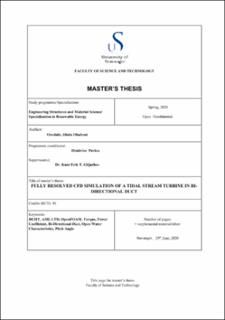| dc.contributor.advisor | Giljarhus, Knut Erik Teigen | |
| dc.contributor.author | Owolabi, Jibola | |
| dc.date.accessioned | 2020-09-25T09:20:43Z | |
| dc.date.available | 2020-09-25T09:20:43Z | |
| dc.date.issued | 2020 | |
| dc.identifier.uri | https://hdl.handle.net/11250/2679637 | |
| dc.description | Master's thesis in Structural engineering | en_US |
| dc.description.abstract | Renewable energy, in it’s present contribution, is inadequate to meet up with the global energy demand. Though the Tidal current energy is known for its inherent great potential, its impact in the world’s total renewable energy is low, hence it is pertinent to study one of the key component of the tidal energy system - the turbine blade.
In this report the performance of a propeller was predicted using BEMT technique and the importance of this theory in the comprehension of an efficient propeller blade in relation to increasing incoming flow velocity on the propeller is discussed. This research study presents the results obtained from the investigation of the flow over an open center high solidity tidal propeller obtained from Framo AS through the use of openFoam as a CFD tool. It also investigated the flow over a BEMT designed turbine blade generated from Qblade which serves as an engineering computational method for the simulation of aerodynamic loads on rotor blades as well as it’s analytical derivations.
In order to meet up with the increased accuracy as a result of complications related to turbine blade design, it was important to consider using the BEMT technique to generate the turbine blade for the simulation. Afterwards, the simulation analysis was performed for each foils that makes up the MHKF turbine blade and for the Framo AS propeller free stream analysis. From the CFD analysis of the open center turbine, the pitch towards the blade root has a high angle of attack at a low TSR resulting in separation of flow at the foil trailing edge which probably contributed to the low efficiency obtained from the simulation analysis. Also, for the MHKF1-180s, 240s and 400 hydrofoils (in order of blade tip to blade root position), their optimum angle of attack amounts to be 15.5degrees, 11.5 degrees and 10 degrees respectively as obtained from the CFD simulation.
Conclusively, the CFD analysis of the Framo propeller in free stream shows that the pitch of the blades should probably be reduced towards the root in order to give an overall optimal flow at a higher TSR. It also shows that the maximum Cp (0.28) is a moderate efficiency for the turbine. Also, the BEMT generated 3-bladed turbine efficiency at flow velocity of 5m/s has a power coefficient of 0.4 at TSR of 4 which is also a little lower compared to the validation case efficiency of 0.45 at the same TSR of 4. | en_US |
| dc.language.iso | eng | en_US |
| dc.publisher | University of Stavanger, Norway | en_US |
| dc.relation.ispartofseries | Masteroppgave/UIS-TN-IMBM/2020; | |
| dc.subject | maskinteknikk | en_US |
| dc.subject | maskinkonstruksjon | en_US |
| dc.subject | bemt | en_US |
| dc.subject | ami | en_US |
| dc.subject | torque | en_US |
| dc.subject | power coefficient | en_US |
| dc.subject | bi directional duct | en_US |
| dc.subject | openfoam | en_US |
| dc.subject | pitch angle | en_US |
| dc.subject | airfoil | en_US |
| dc.subject | mhkf | en_US |
| dc.subject | CFD | en_US |
| dc.subject | byggkonstruksjoner | en_US |
| dc.subject | fornybar energi | en_US |
| dc.title | Fully resolved CFD simulation of a tidal stream turbine in bidirectional duct | en_US |
| dc.type | Master thesis | en_US |
| dc.subject.nsi | VDP::Teknologi: 500::Materialteknologi: 520 | en_US |
